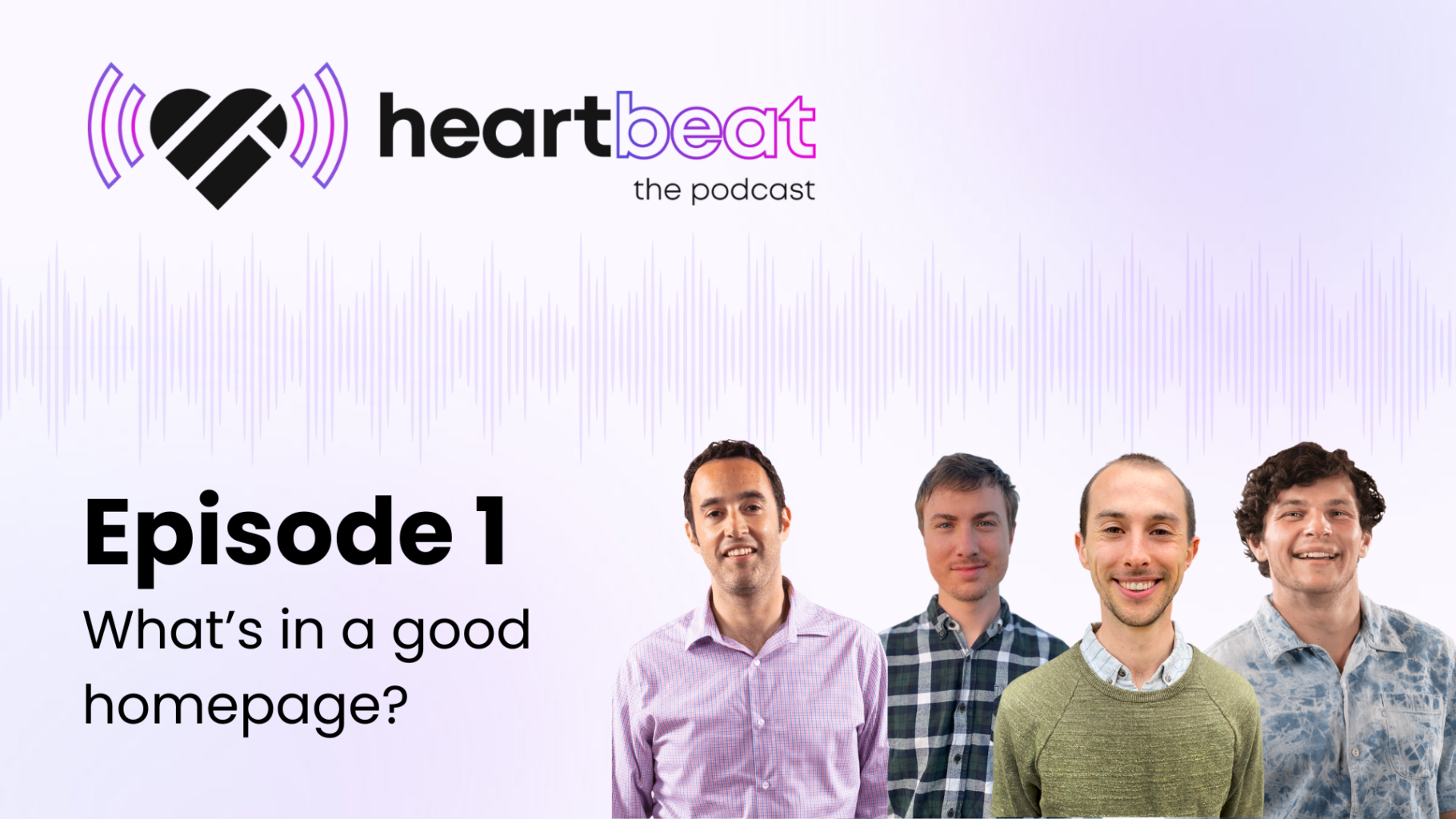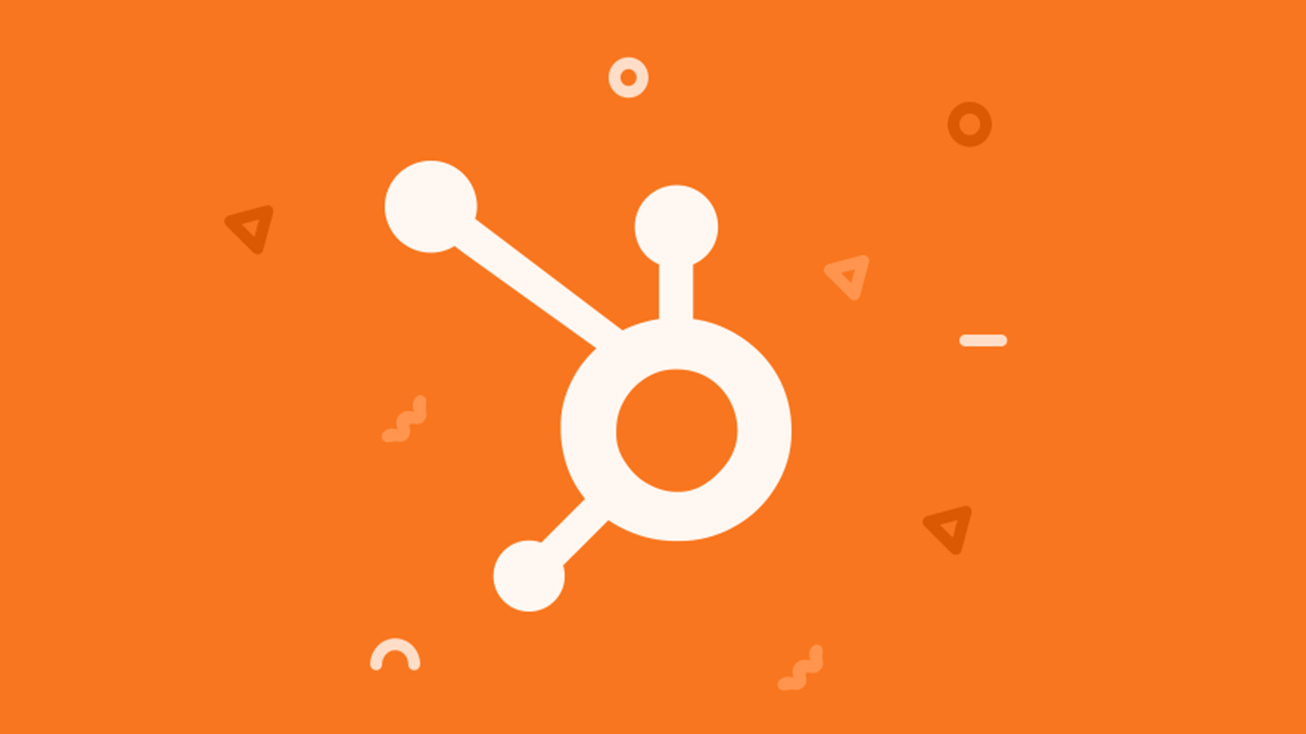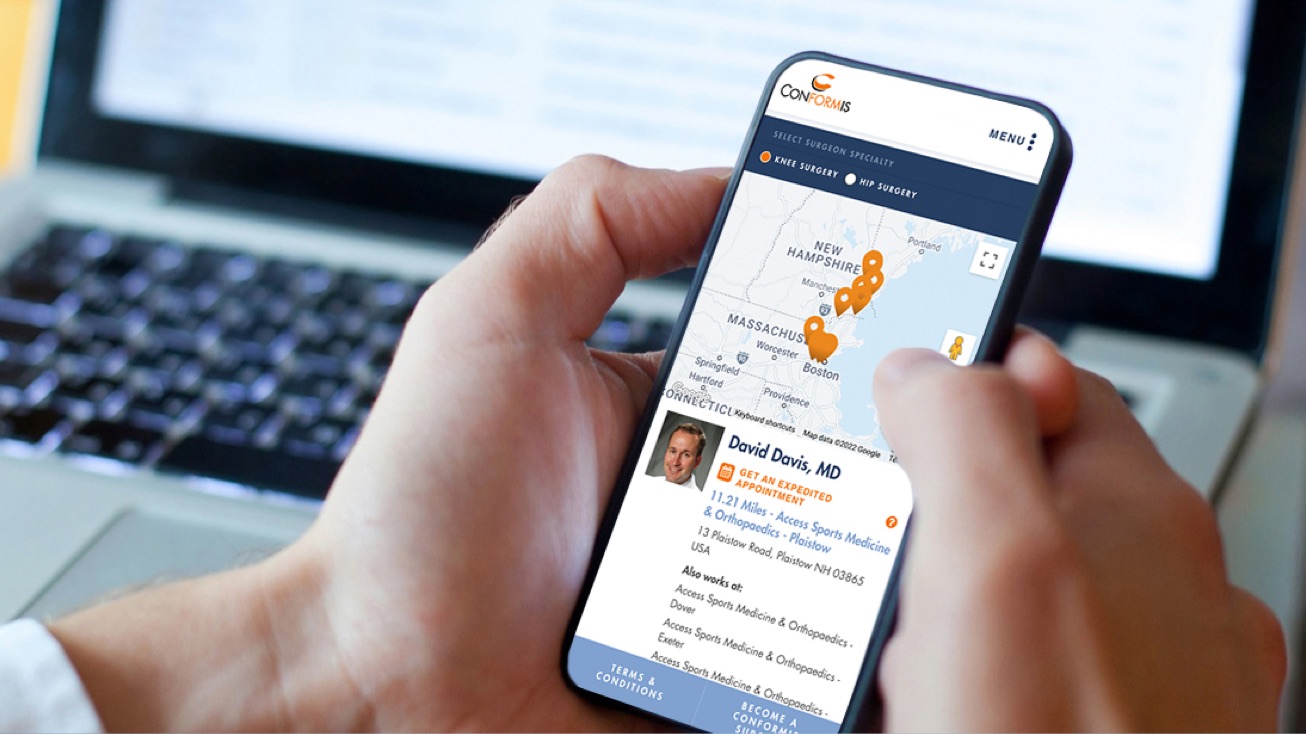It’s our first episode of The Heartbeat Podcast by Digital Impulse! Thanks for listening.
In this episode Conor, Andrew, Roland, and Joe dive into a big, big topic: the crucial elements of a website’s homepage.
The conversation revolves around defining a homepage, its role as a digital face for your site, and the importance of clearly communicating a company’s identity and mission.
We also delve into the challenge of making a homepage effective, particularly for the majority of websites that lack global brand recognition, including:
- The need for clear communication about your company’s most basic info
- The importance of the homepage hero section, the top part of the homepage, as the first impression and a critical conversion driver
- The role of navigation in user experience, and the importance of an intuitive design and homepage navigation
- Whether the burden of generating sales can really be placed on the homepage, and how to make that most effective
Listen for more of our insights into approaching homepage design for niche companies with complex offerings–and how we help make homepages some of the most effective assets a brand can offer.
Transcript below.
Conor Snell: Hey everyone, you’re listening to the Heartbeat Podcast with Digital Impulse. I’ll go around with intros: I’m Conor Snell.
Andrew Kolidas: Andrew Kolidas.
Roland Davin: Roland Davin.
Joe Gallo: Joe Gallo.
CS: Awesome, thanks guys. And yeah, today we’re talking about, you know, a big topic that we cover, basically the first place we start, most of our website builds and thinking: the homepage.
What makes a good homepage?
What makes a homepage effective?
And how do we think about building a good homepage when we get into it?
So I figured we would start there. We got Joe, a designer. We got Roland, Marketing Director, Andrew, CEO, I’m the Content Director. So basically wanted to start there. So let’s define a homepage. What is it? What is a homepage?
AK: Yeah, I mean, I look at it as your digital storefront for whatever you do. I think as simple as that. You have to tell people – literally, the first step is “what do you do?”
And that’s something that is commonly missed at a lot of websites that we look at, analyze, or our clients coming to us, needing a new one. Sometimes it’s just really hard to understand what a client does. So I think for me personally, it’s clearly defining who you are is just mission critical.
CS: So some of the most basic, just like, this is the name of our company.
AK: Yeah, I want to make a caveat to that. If you’re Nike, OK. Big brands with global name recognition play by their own rules. So we could have this conversation about those types of company. We might say it’s saying totally different.
But for the 99.99% other websites out there, you have to tell people what you do. Because they might be looking for something, they might be looking for what you do. Once they know they’re in the right store, then they’re going to spend time with your site. You have their attention, and now they’re going to shop for those pants or whatever. But if people don’t know that, then you’ve already lost them.
RD: You good test would be if your entire C-suite exclusively flies private all year. You may not need to explain it, right?
But it’s a big jump. I think that, yeah we see that a lot. We know who we are. This homepage isn’t for you. This is for everybody else, but you most of the time.
CS: Well, there’s a corollary I was thinking of. For most businesses, I was talking to Joe about this before, your homepage on your website is, in all likelihood, probably going to get 1,000 times more visitors than your office ever will.
For Nike, that maybe not the case. But I mean, generally, we talk all the time about this with accessibility, too; your building has to be accessible, so does your website. And it’s just a testament to how important your site is and the homepage is the central gathering point for everyone that hits your site.
Joe, what do you think?
JG: I think you got to make sure that you’re hitting all the points. So somebody might have a certain touchpoint with your business or your company, but you got to assume that a lot of the people hitting your website for this first time, oftentimes the homepage is that first engagement that they have with your brand.
So you really got to put your best foot forward and open the doors and show them who you are. And make sure that whether they have seen your brand, they know your logo or not, that you’re telling that user what it is that you do and really offering up the navigational points to tell the story of who you are and then getting them what they need.
CS: I think that’s dead on, Joe. We talk about this a lot. I think the most, maybe the most important pixels on your entire site are the hero of your homepage. The very first thing someone sees before they do anything, before they scroll.
We talk a lot about the right language there and the right links and navigation. So what do you guys think about that very first view? How important is that? What are some of the big picture things you would use as your guide for executing a really good homepage hero?
AK: I mean, I think going back to if somebody knows who you are and you really define that in a clear way, you have to tell them the why. Like, why is this company different or better at providing the service or the product that you’re looking for?
That’s where you really about your unique differentiator. Like, what is that clearly show that? Now listen again, the 99.99 rule. If you’re Nike, maybe it’s the latest ad campaign. You want to get somebody feeling about something or the goal of that area is to brand a new tagline.
RD: It’s provocative.
AK: Yeah, exactly. But if you’re not doing that, let’s say you’re a website design agency, we build the best websites. Okay, well now I know why we’re here and what you guys do and now why I should use you guys. Now you need the supporting content. Obviously that’s oversimplified, but that’s sort of my view.
CS: Joe you had mentioned that there’s some amount of continuity you have to consider if someone has a perception of your brand from ads or from social and then they hit your site. There should be some kind of connecting thread between those. I wanted to get your thoughts on how you connect those pieces and what that first view should look like if you have a preconceived notion.
JG: Yeah, I mean, the user experience, they might have a touch point. They might not either way. Consistency is really key. Just maintaining that look and feel of the brand, whether it’s in the copy, the voice, the visual, the elements. It all is going into that big, big story.
And the consistency is huge. Typography, colors, it’s going to make things really just more intuitive as they navigate the site. And also just really reinforce who they are. So you want to have a consistent message throughout. And I think that homepage and above the fold, that hero is that first intro into that.
RD: This guy designs.
AK: Job, you done this before? Asking for a friend.
RD: I think the one thing that Joe mentioned that I think is so important is the intuitiveness of the experience when you hit the website. And something we talk about in the marketing side is sort of a different way of framing it, but is it self-evident?
When I get here, is it obvious what I should be doing next?
You get there, say “I know who this is now. Maybe I know what they do.”
All right. Now I want to know why they’re the best. How do I do that?
If you’re like using that Andrew Kolidas narrative arc there, are we making sure those things are really obvious?
And I think that sometimes just like asking those big questions, if you can get those things right, I think the first thing is you need to agree is a company, what the answers to those questions are.
AK: Absolutely.
RD: Which is really hard. But then once you get there, I think execution, if you can do those things, you’re in pretty good shape.
AK: You know, Roland, on that point, I think you’re dead on the money there. Sometimes we go into a client where like, what’s your mission statement? And they have some like well thought out phrase that defines who they are, everything like that. Sometimes they’re like, well, it’s kind of in flux right now or we’re maybe going in a different direction.
That’s when you get those headlines that are like “Science and innovation combined for the future.” And you’re like, okay, I have no idea what this is.
One point, Joe, you brought up something really, really important. Your navigation. When we talk about clearly defining who you are and what you do, it doesn’t have to be done in some like crazy prescriptive way above the fold. If your navigation says web design services or something of that nature, then you don’t have to go in and use that header to clearly say we offer that service.
So the navigation is one of the most important things of defining your service offering and it meets your UX UI needs. So Joe, when you’re designing a navigation, how does that really factor into your thinking?
JG: Yeah. So I’m just taking a step back. There’s so many different things to consider for the website. You know, you’re looking at the users, who they are, how many times have they been there, how well do they know the company? And that’s obviously a lot to really think about.
But you don’t need to do it all at once, all in one space. And I think the navigation plays a crucial role in that. And thinking about what are the most important things? That’s again, going back to hierarchy and then language. You know, what actually is resonating with the user in terms of how are you referring to these services?
Is it a product?
Is it a service?
What’s going to really resonate with the user and make things intuitive?
So navigation, obviously huge and simplified. That user experience, making sure that things are clear, not too cluttered. You know, there’s a golden rule. They say no more than seven items. And this changes depending on the client. You know, I think certain people can get away with it, but less is more. What is it that we want the users to do? What is that next step? And prioritization of the ordering? All that goes into it.
CS: I totally agree, Joe. I think that’s really well said. And I think that comes to something you mentioned Roland, too. Like, a home page is really the place on the site where brand and communicating the brand value and functionality.
Like, the utility of the page itself really come into play. It’s curious what you guys think about that home page as a conversion driver. Like, if we think about next steps or what you want to do from a home page, obviously, that’s super important, but can the burden of generating sales be put on a home page? Or is it required that that be connected with a more finite conversion point?
RD: Oh, you can definitely put it on the home page. I think if you’re not putting the honest of conversion on your home page, you’re taking the easy road, which, I don’t know if it’s a hot take or not, but I would say that if this is the place that most people go, the most people land. And a large percentage of them are brand naive.
This is your first best and potentially only shot to hook them in. You have to be completely committed to the idea that most people aren’t even going to go below the fold. They’re not going to go much beyond your hero. So if you don’t engage them, that group has gone forever. So I would just say that that’s not negotiable. That should be non-negotiable.
AK: Well, I think every website has a different purpose too. So we have to look through a bunch of different POVs. So for instance, we work with certain clients that have a large offline media spend. We’re talking TV, radio, billboards. Those mediums are actually selling somebody on the service. They’re doing the job of defining who they are, who the service is for, why they should use it.
So with them when they get to this homepage, the number one job is to convert at that point. So it really depends on a company’s structure, their media mix, and what their overall sales goals are. So sometimes it’s not as straightforward as we might think.
RD: Yeah, I agree with that. There are definitely going to be instances where you have someone come in and the value prop is really nuanced. Super long sales cycle. I think that maybe a better way to frame what I said before would be to say,
“You need to engage the person starting at the homepage.” So they may not need to literally convert above the fold, but you need to have a very clear vision of what they are going to need to do to eventually convert. And I just understand how that experience in the hero above the fold is going to start them on that journey.
CS: Totally. There’s not only, there’s always just one way to convert on a site. I talk all the time about hard and soft conversions. Sometimes a homepage hero is like the best place to just like, “I just need more information, I just want to talk to somebody.” It’s not, “I’m ready to make a purchase.”
And I think we do a lot of calculus for clients. Like, what is the right way to engage someone and get them to take an action that’s maybe not like too far down the road. It’s going to scare me off.
AK: Yeah, I think that’s a good call.
JG: Yeah, and you know, sometimes it’s not even conversion that people are looking for. You know, they have different goals for the website. Like, maybe this is a resource for people who already have the product. And that is the main goal. You know, conversion is usually a big one for clients. But, you know, we’ve had clients before where it’s really just about informing the user on a subject.
And, you know, the actual contact or that, you know, final touch point is a lot less important. So it’s really an asset. You know, the site is an asset. And the homepage is the navigation for that. You know, whether it’s the actual navigation, the header or just scrolling down the page, engaging people in different ways so that the user who’s ready for something or looking for something, you know, there’s different jumping off points and different user flows into the rest of the site—or the rest of the book, really.
CS: I think that’s a great point, Joe. We talk a lot about web pages as, you know, there’s a, there’s a cutoff on scroll. You hit a certain point halfway down and you’ve lost 50% of the users. Just as a function of that’s how people use a website.
But for a homepage, I feel like we do a lot of thinking around like how could we maximize the value of the bottom of the page? Like what is the last module that is a potential conversion point? How do we use the homepage as a way to like lay out the user journey further through the site? So I think, I’m curious what you guys think about the lower part of the page? How we can utilize that?
AK: You know what? Like that’s a really, really good question. Because I think that people look at data wrong, right? So here’s a, for instance, a lot of times we’ll put heat mapping on a homepage. And, you know, the top obviously red, you go down, oh, there’s 50% of the people and then you get to the bottom and you see that cold, that dark blue, and they, oh no, failure. And there would be something important down there, like a form to like learn more. And people are like, oh no, it’s like the website’s on fire, it’s failing.
No, actually, those 15% of the people who got to the bottom read all the content. And those are your best, most qualified users. So when they do take the action, we’re talking about high quality leads or sales ops or people who are in your CRM that had intent. That’s actually, it’s a good filtering system. We should be saying, wow, 15% of the people actually got to the bottom here to read your entire brand story. We know people are going to jump off on modules.
That’s supposed to be the case. But these are your most engaged users. That’s a good thing. So part of it is the way an agency presents data in, informs our clients about what it means.
RD: Yeah, if your business doesn’t run on impulse purchases, you should care about who’s getting to the bottom of that whole page. Yeah, I totally agree. And sometimes you have sales people who don’t want the looky-loos. Like, you have some clients where it’s like, it’s sort of like they want those silver platter leads where they’re ready to go. Because that’s how the sales force is constructed.
That CTA at the bottom that only gets 15% of people are your best leads. Those are going to be the most sales qualified and the sales team will love them. So, to answer your question, the bottom of the page is critical to sealing the deal with your most engaged audience. Don’t be fooled by the metrics. It’s all about the result.
JG: Yeah, definitely, Andrew. And I think like, you know, if you’re doing your job with the homepage, you’re offering points where you can jump off. And a lot of the times, that’s why you start seeing things get cold as because you’re already engaged. You have a user that’s like, oh, that resonates with me. I’m going to learn more because that’s what I’m here for. If not, you’re telling a story.
So, we oftentimes look at the homepage as a complete succinct story. And depending on how much the user knows, maybe you’re telling enough of the story on the homepage and the fact that they’re scrolling further. You know, they might not know enough, but you’re doing a great job there and then boom for your point at the bottom.
AK: Yeah, I have a question for you guys. And this is sometimes the case and sometimes not. So, I don’t want to see the answer to the question. I haven’t asked yet. But how do you feel as the homepage being the menu of what’s inside the website?
Sort of like you know, you go to the cheesecake factory. You’re like, okay, I need a minute here. Opening this thing. But you have the different categories. It’s, it can educate you about what’s in the experience. Or do you think that’s like not important at all? I’m curious your takes.
CS: I mean, Joe, we work on a lot of homepages for a lot of client sites. That is really the way. I think that’s really the framework we take into it is like, try to understand the totality of the user journey from the get go. And then create a homepage that can serve as like jumping off point into some of those most important parts of the site. It really should reflect like it’s a condensed version of the entire user journey. Not giving away the ghost on everything, but certainly like offering places to get into deeper parts of the site.
Just because it’s a, it’s a factor of volume, right? There’s an X amount of people, the most people are hitting your homepage. So you want to give as many people as possible those jumping off points who may not explore the nav.
JG: Yeah, hopefully it’s a, you know, a curated menu. We’re going to go back to that analogy because you don’t want to be overwhelmed with all the options. But we do have, you know, really we have to focus on what is the most important spot. And then maybe they open up to the next page, you know, or that click that gets them further into that menu that’s, you know, even further focused in on what they’re already interested in.
AK: Yeah, just don’t include the calorie count.
RD: I think, you know, the Joe mentioned this earlier and it’s so important, right? It’s this idea of prioritization. I think one of the things where a homepage can go awry and this is not what, you know, I think Joe and Conor were talking about earlier.
But there’s a thing where the homepage goes awry because it’s a function of compromise. Internally, within the client, they cannot agree on what their priorities are. And therefore everything is a priority. You have two business units that bring in 80% of your revenue and six business units that bring in the remaining 20. And you got eight evenly divided on the homepage. That’s not reflective of your business. And it’s probably not even reflective of where you think your business is going to be for the next three to five years, which is the likely the lifespan of this homepage. That’s max, right?
And so think about it. What I think maybe a good question for people to ask themselves is realistically, how long are we going to have this homepage for? Right? It’s a living sort of, I’m going to call it a living document, living, you know, breathing thing. And so if you think that your business priorities for the next two, three years are these three things, don’t put the other five there.
AK: You know, one important point on that is we do a lot of consulting with C-suites and different groups in companies that all on homepage real estate because they’re looking at that as sort of proving how important their division of the companies. So let’s say you have a client that has five different products. You know, let’s say shoes, pants, shirts, whatever it may be, whoever is managing shoes is like, yeah, shoes needs the prime spot on the homepage.
So Roland, exactly to your point is trying to like, placate people and say, well, I got to give this person their real estate. Oh, I gave them the shoes, so I got to put the pants up there. And then your entire homepage looks like sort of the back page of a magazine that has a little tile ads all over it and it doesn’t make any sense or flow. So part of what we do is educate our clients to say, honestly, you probably don’t even want that spot on the homepage.
What you do want is the next page after somebody self-identifies who they are because now you’re getting the right person to look at this, the person who is looking for shoes. Now put your products at the top. That’s how you’re going to get the right eyeballs and the most business impact. So sometimes it’s like pivoting the conversation away from the homepage as being like how important you in your division of a company are.
RD: Yeah, almost helping that internal stakeholder.
AK: Exactly. Exactly.
CS: I would like to keep this convo going about maybe in another combo about how you juggle those priorities for homepage and have all those things. And also we’ve worked with clients before who create a homepage to be an aspirational North Star for how they want to grow their business. We want the business to look like this in a year or six months. Let’s create a homepage structure that reflects where we want to be and maybe that can be the lead in that.
AK: Yeah, I think I think that’s a great deal. A question, I kind of for you and for Joe, we work with a lot of niche companies that do very complicated things for very complicated personas and different audiences and the products or had nothing to do with each other, maybe loosely related.
When you get a company on board that has such a complicated situation, what is the approach you take to kind of decipher that and distill that into the right homepage for their company?
CS: Do you want to go first?
JG: Yes, sure. I mean, I think it really starts with listening to the client and really hearing from stakeholders and people who are in the weeds with it who understand the users. And what I love to do is to hear from the users himself for the website. So even ahead of the design, really just getting the landscapes, understanding the complexities of the business, the products and how they relate, then kind of taking a step back, digesting all of that information and saying, OK, given these priorities and these users, how do we best simplify this complicated experience so that it really is intuitive, make sense?
And it is not overwhelming. We don’t want that analysis paralysis where it’s just too much at once, but there’s oftentimes in the weeds of things that solution that will just hit and really simplifies the most complex situation. I know, Conor, we’ve worked closely with that. So I’m sure you can get in the weeds in, you know, different ways in terms of how you think about the user.
CS: Totally. I mean, we have to become experts on what our clients do and what their value prop is and they’re offering, but we’re also an external third party. I think that can be a helpful, like, refreshing viewpoint. But yeah, definitely takes conversations with users and with people on the team to really understand what some of those value props are and what the, what the rate of execution is. That’s what we do. That’s our whole, you know, gambit here.
Yeah, awesome. Cool. Thanks guys. I think this is a great convo. Let’s pick it up. Let’s keep talking about homepages. I think there’s a lot to go there.
RD: Homepages are a party. What’s not to like?
CS: Yeah. Awesome. Well, thanks for listening to the Heartbeat podcast. I’m Conor Snell.
AK: Andrew Kolidas.
RD: I’m Roland Daven.
CS: Thanks guys.
Want more insights from our experts? Subscribe to The Heartbeat Podcast by Digital Impulse wherever you get your podcasts, or click here to browse all episodes! 💜





